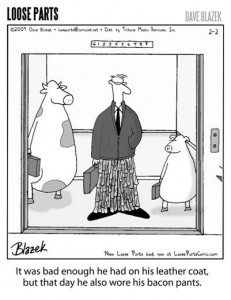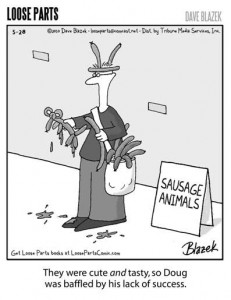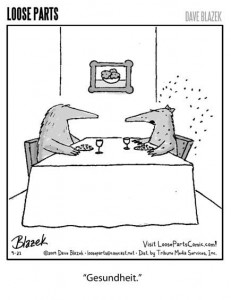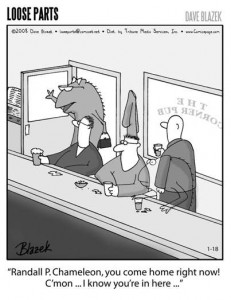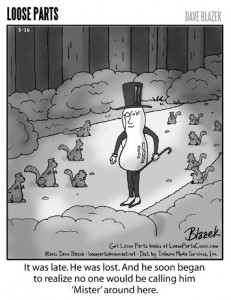Dave Blazek is the creator, writer and artist of the comic “Loose Parts” and what an extremely humorous and talented man he is. Dave has worked as a standup comic, writer, graphic artist, and produced and directed for radio and television commercials, and written for Dr. Katz Professional Therapist. Plus he has won over 130 regional, national and international creative awards in advertising. Dave has a new book called Attack of the Chortling Stomach, which will have you rolling with laughter, and you can find the book at his website loosepartscomic.com/LoosePartComic.com.html . So if you aren’t already familiar with Dave and “Loose Parts” you are in for a treat. What a thrill it is to have Dave Blazek featured here at “Don’t Pick the Flowers”.
David: Hello Dave! Thank you for being featured at “Don’t Pick the Flowers”. You have a great sense of humor and a great comic called “Loose Parts”. You’ve been involved with many “entertaining” jobs like writing for “Dr. Katz Professional Therapist”. How did Loose Parts and your involvement in cartooning begin?
Dave: I was taught by wolves. All right, all right, the story is much weirder. I’m an unusual cartoonist in that I never drew a picture in my life until I was 43. That’s right. I never grew up wanting to be a cartoonist; never knew I had it in me. Instead, I graduated from Penn State with a Journalism degree hoping to be the next Woodstein. Well, that didn’t pan out so I went to work in a factory making cardboard boxes in my hometown of Erie, PA. After getting laid off from that glamorous position I begged my way into a job at the Centre Daily Times in State College, PA, the town where Penn State is located. They gave me a job selling advertising to used car dealers and anybody else in the phonebook. Thing was, I wasn’t such a good salesman. But it turns out, I could make really clever ads and those seemed to sell pretty well. That sent me down the road of Advertising. A few years later, I got a job at the in-house agency at The Philadelphia Inquirer and Daily News. I’m still there to this day some 30 years later. I know what you’re thinking and you’re right. I have a full-time career other than cartooning. I do all my cartooning nights and weekends. In the meantime, I’ve created scores of ads; I’ve written and produced over 500 radio commercials; and I’ve written and directed over 100 TV commercials. Somehow I have this basket of 130 creative awards including a Clio. They make tremendous weapons and doorstops. There are many people who only know me from that career and have no idea I cartoon.
So how did I start cartooning? We’ll get there. I should add that I did a lot of funny ads beforehand. And that while I was in college, I was editor of the Froth – the National Lampoon or Onion of Penn State. And then in the ‘90s, I tried my hand at standup comedy and did that for five years or so in and around Philadelphia. So you see, even though I never cartooned, I was developing the comic sensibility as I bathed in humor in many different forms and media. Of course, dirty humor bath water leaves a horrible ring.
Okay, so here we go. The Comics Editor at The Inquirer, because of my humor background, started showing me the comics submissions to The Inquirer and asking my opinion. I kept saying “I could do better than these.” He got tired of my saying that so much he challenged me to try. I ignored him. He asked again. I ignored him. He finally retired and was doing some talent searching for the then Los Angeles Times Syndicate. He asked again. I ignored him. Finally, around the tenth time, I said okay. But I didn’t draw. Luckily I had a partner who did. So one weekend, I wrote, like, 30 cartoons and my buddy went and drew them up. They got to LA and the next thing I know, their VP flies east, takes us to lunch and signs us to a syndication contract. We originally called it Off The Mark not knowing Mark Parisi had Wide of the Mark. We were stupid. So we sent a list of 10 names to LATS and they picked Loose Parts. Yeah, yeah, I know. It just isn’t supposed to happen like that. But I suspect that our old editor friend vouched for us mightily, and I know that years of working on daily newspaper deadlines made us a safe bet. But still, the legendary editor Ron Patel came to our office and just kep saying, “You have no idea what you’ve done. None. No idea, no idea whatsoever …”
So we start up Loose Parts in 1998 and just a few weeks in, LATS asks me to write for the comic strip for Dr. Katz. Love it. So I’m now writing 60 jokes a month and working full time and life is good. Then in one weekend, my friend and partner tells me he has cancer and wants to stop Loose Parts. (He’s fine now. I see him every day.) Then Comedy Central cancels Dr. Katz. Now I’m looling like I’m out of the cartoon business as fast as I got in. So I do something nuts. I call LATS and ask if I can draw Loose Parts as well as write it. Amazingly, they say, yes. So now I have a daily cartoon and I need to learn to draw. Right after I vomit. I sit down and I crunch like I was cramming for medical school. It took me hours each day just to do one. And truth be told, that first year of Loose Parts looked pretty fugly. But something magical happened. My weird way of drawing matched my humor sensibility and the panels got stronger somehow. When the LA Times Syndicate folded, Tribune Media Services took me on and I’ve been with them every since.
But every day it got easier and easier. And now, over 4,500 in a row later, I can probably call myself a cartoonist.
David: I love your sense of humor and the style of Loose Parts. What are the things that spark your creativity and imagination, any daily routine?
Well, if you waded through that large paragraph above, you can see that I’ve been steeped in humor from high school on. Before I ever wrote a cartoon, I had spent decades trying to make people laugh. So I know the structure and timing of a joke. And from directing, I know how to block out a scene and direct the eye.
But I’ve always loved the obtuse sophisticated humor. Monty Python, for sure. Robert Klein. Robert Benchly. Woody Allen. And more recently, the late Mitch Hedberg and now, Demetri Martin. I like to think that you don’t have to dumb down humor to make it funny. Standup producers used to rag on me as being too cerebral but I found that when people have to work a little to figure a joke out, it has a lot more impact when it hits. In fact, that’s what I consider one of the secrets to comedy: you let the audience complete the joke in their heads. You don’t spell it out for them. It makes the humor more involving, more stickier.
As for a routine, well, I used to walk around thinking of gags all the time. But being ‘on’ all the time was burning my brain out. So now, I usuallly write on Monday nights. I go into the bedroom, put some classical music on, lie on the bed, stare at the ceiling and I don’t come out until I write 10-12 jokes. Of those, seven will get drawn later that week. After all these years of having to come up with ideas, I’m pretty fast. It generally only takes me 60-90 minutes to write the Loose Parts for a week. I then draw the bulk of the cartoons on Saturdays, though I’ll often pump one or two out during the week if I have time. Then Sundays are reserved for doing the color work on the Sunday Loose Parts. Then, once a month, I just reserve chunks of hours to shade and prep the mechanicals. And since Loose Parts runs in both panel and strip format, that means I have to prepare 48 dailies and 4 Sundays every month.
Oh, and I have another comic I do as well. It’s called Biz. It’s a workplace-themed panel. It ran for three years on the business pages of The Philadelphia Inquirer and now is being syndicated through the new Ink Bottle Syndicate.
Yeah, you got that right. Day job. Two cartoons. Freelance business. Still want to be a cartoonist?
David: I’m a bit in awe of your comics, if you hadn’t of gone in the direction of comics, what do you think you’d be doing?
Well, as I detailed above, I said above, I did go in another direction. Half my life is in Advertising so in some sense, cartooning is my other direction. But I’d like to get back to doing standup comedy again one day. It’s the opposite of cartooning in a way. You get immediate feedback. Where with cartooning, sometimes you get no feedback and that makes it hard to gauge whether you’re hitting or not. And sometime, I’d like to give improv a whirl.
David: Who are some of your cartooning hero’s and what makes a good comic?
Well it’s not hard to see that the Far Side was an influence. And B. Kliban opened my mind to what could be done. These days, I like to read Mark Parisi and Dave Coverly and Dan Pirraro and Tony Carrillo. And I always say, nobody but nobody draws funnier than Glenn McCoy.
There are two things that I think make a good comic. One I spoke about above. You build the joke so the reader finishes it in their head. Here’s an example in the form of an old standup joke of mine.. “Did you hear about that guy who wrote a book on how to commit suicide? And it made the NY Times top 100 seller list! …….. Boy, here’s a book that’s overdue at a lot of libraries.”
See? I didn’t provide the punchline. You did. In your head. Dead people don’t return books.
The second secret is to have the style of your drawing match the tenor of your humor. That’s why I’m always amazed when partnerships become successful. It takes a lot of communicating to get the artist to draw it just the way it’s conceived. I make so many tweaks along the way, I could never relinquish control again.
David: What advice do you give to anyone wanting to make comics?
I’m not the only one to say this: focus on the writing. It’s the core of the cartoon. I’ll tell you a story. A year after the LA Timers Syndicate let me take over drawing Loose Parts even though I didn’t know how to draw, I called them and asked them what the hell they were thinking. They told me, “We were thinking it was easier to take a funny person and teach them to draw than to take someone who drew and teach them to be funny.” So there you go.
Second thing: focus on the graphic art of your strip. I see so many funny cartoons that are laden with the crappiest fonts, bad frames, horrible logos and more. Design matters. Almost as much as the drawing.
And third: You have to be disciplined. Being a daily cartoonist is a long distance run and not a sprint. (In fact, I am a runner. I log 400-500 miles a year and have for three decades.) You have to stay out in front or the wave will just swallow you. And that’s where the just plain love of the craft comes in. If you don’t love it, you won’t keep up and the stress and desperation will show in your work.
Also, I’m an idiot.
David: What is the legacy you’d like to leave behind with Loose Parts.
I’d like people to say that I had a small part in preserving the intelligent sophisticated humor made famous by the Far Side. If Larsen is Frank Sinatra, I’d love to be Michael Buble. Not sure I’m anywhere near even that though.
And I’d like to be known as a pro; someone who always tried to deliver a joke, never mailed it in and never missed answering the bell.
And I’d like to smell good, and be able to levitate, and have the nuclear lunch codes. (Not the launch code; the lunch codes, cuz I get hungry.)
David: Thank you so much for the words of wisdom and the humor. You always deliver a great comic! And thanks for being featured here at “Don’t Pick the Flowers” and sharing about your life and how to make a great cartoon!
Check out more of Dave Blazek and his new book Attack of the Chortling Stomach, at “Loose Parts” http://loosepartscomic.com/LoosePartComic.com.html . You can see cartoons, get a behind-the-scenes look, and order any of his books at www.LoosePartsComic.com.

